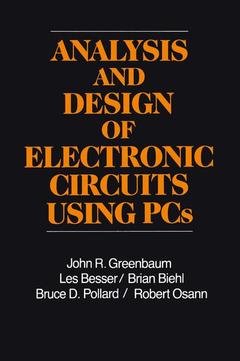Analysis and Design of Electronic Circuits Using PCs, Softcover reprint of the original 1st ed. 1988
Langue : Anglais
Auteur : Greenbaum John

Since the mid 1960s, the digital computer has been used as a design tool by electronic circuit designers. Computer software programs called ECAP' and 2 SCEPTRE were among the earliest circuit analysis codes to gain general acceptance by the design community. These programs permitted circuit perfor mance to be simulated for small-signal frequency responses, dc operation points, and transient responses to varying input stimulii. Unfortunately, accessability to programs such as these by the design community of that era was quite limited since they could be used solely on large, expensive mainframe computers. Only a fraction of the circuit designers at that time were employed by companies large enough to afford the acquisition and maintainance costs of these large computers. The availability of personal computers (PCs) at moderate prices has dramat ically changed this picture. The sophistication of the PCs as well as the software that can be run on them has potentially put circuit performance simulation at every designer's desk. Since the early days of ECAP and SCEPTRE, the amount of software for circuit design and analysis has grown enormously. At the same time, the sophistication of the analyses provided by this software has corre spondingly increased. In addition, the accuracy of simulation software has improved to where laboratory measurements have become a verification of the analyses, rather than vice versa.
1. Introduction.- 1.1. The Role of Pcs in Circuit Analysis and Design: An Overview.- 1.2. Desirable Characteristics of Circuit Analysis Programs.- 1.3. From Analysis to Design.- 1.4. Organization of Book.- 2. PC Basics.- 2.1. Introduction.- 2.2. Number Systems, Codes, Bits, Bytes, and Words.- 2.3. Hardware.- 2.4. Software.- 2.5. Special Topics.- 2.6. Conclusion.- 3. Ac, Dc, and Transient Circuit Simulation Programs.- 3.1. Introduction.- 3.2. Three Circuit Simulators for PCs.- 3.3. Architecture of a Circuit Simulator.- 3.4. Modeling.- 4. Computer-Aided Design at Microwave Frequencies.- 4.1. Historical Review.- 4.2. Circuit Analysis.- 4.3. Circuit Synthesis.- 4.4. Transmission Line Analysis and Synthesis.- 4.5. Circuit Optimization.- 4.6. Statistical Analysis.- 4.7. Active Device Modeling.- 4.8. Circuit Contents Layout and Mask Design.- 4.9. Nonlinear Circuit Design.- 4.10. Illustrative Examples.- 4.11. The Future.- 5. Digital Design and Analysis.- 5.1. Introduction.- 5.2. PLDs Proliferate CAE on PCs.- 5.3. PALASM, the First PLD Design Language.- 5.4. CUPL, the First High-level Universal Language for PLDs.- 5.5. ABEL, first High-level PDL Language with State Machine Capability.- 5.6. Arrival of High-level Design on PCs.- 6. The Use of PCS for Industrial/Laboratory Automation.- 6.1. Introduction.- 6.2. Basics.- 6.3. Connecting a Digital pH Meter to a Computer.- 6.4. Serial Interfacing (Asynchronous RS-232C).- 6.5. Analog Signal Acquisition.- 6.6. PC-based Robotic Workstations.- 6.7. Summary and Conclusion.- 7. Special Computer Codes.- 7.1. Introduction.- 7.2. Fitting General-order Polynomials.- 7.3. Designing T- and Pi-Pads.- 7.4. Calculating “L”-Networks.- 7.5. Bandpass Filters.- 7.6. Cad Cuts Math in RF Amplifier Design.- 7.7. Simulating a Servo System.- Appendix A Glossary of Terms.- Appendix B Bias-D Reference Manual.- E-1. Introduction.- E-2. Input Data.- E-3. Miscellaneous.
Date de parution : 03-2012
Ouvrage de 278 p.
15.2x22.9 cm
Disponible chez l'éditeur (délai d'approvisionnement : 15 jours).
Prix indicatif 52,74 €
Ajouter au panier
© 2024 LAVOISIER S.A.S.



